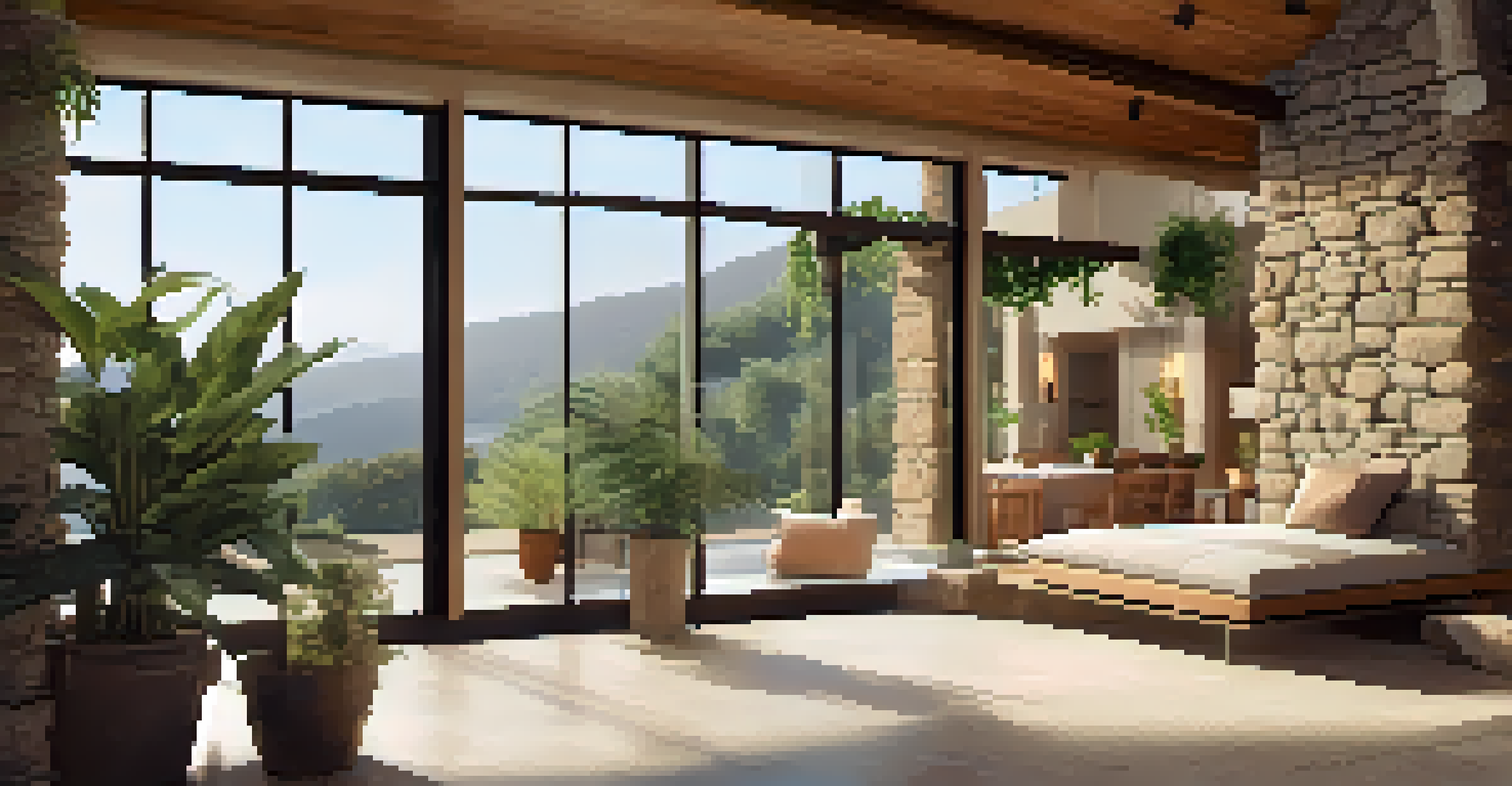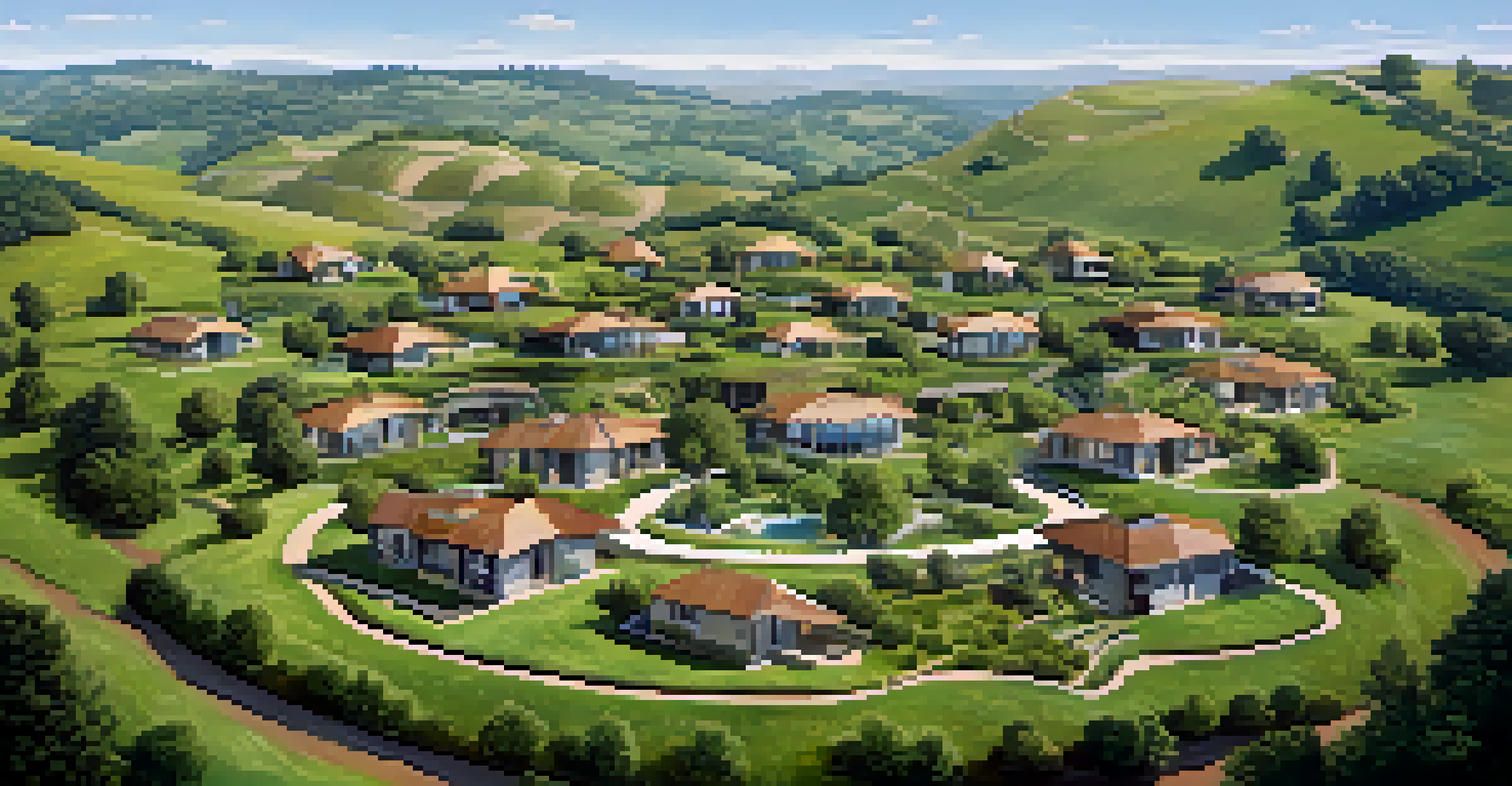Using Earth Sheltered Homes for Energy Efficiency Benefits

What Are Earth Sheltered Homes and Their Benefits?
Earth sheltered homes are unique structures built partially or entirely underground. This design not only blends seamlessly with the landscape but also provides several benefits over conventional homes. By utilizing natural terrain, these homes reduce the need for heating and cooling, making them energy efficient.
The best way to predict the future is to create it.
One of the standout features of earth sheltered homes is their thermal mass. The surrounding earth acts like a natural insulator, keeping the interior temperature stable across seasons. This means you can enjoy a consistent, comfortable living environment while using less energy for climate control.
Additionally, these homes can significantly lower utility bills. By harnessing the earth's natural insulation, homeowners often find themselves using less energy, which translates to lower costs. It's a win-win scenario for both your wallet and the planet.
How Earth Sheltered Homes Enhance Energy Efficiency
The energy efficiency of earth sheltered homes stems from their clever design. By being partially buried, these structures benefit from the earth's natural temperature regulation. This allows for less reliance on heating systems in the winter and cooling systems in the summer.

Moreover, the thick walls of these homes, often made from concrete or other dense materials, further minimize heat loss. This insulation effect means that even in extreme weather, the interior remains comfortable without excessive energy use. It's like having a cozy blanket wrapped around your home!
Energy Efficiency of Earth Sheltered Homes
These homes leverage natural insulation from the earth, resulting in lower energy consumption and reduced utility bills.
Incorporating energy-efficient windows and ventilation systems also plays a crucial role. These features allow for natural light and fresh air while maintaining the home's energy efficiency. Together, they create a harmonious balance of comfort and sustainability.
The Role of Passive Solar Design in Earth Sheltered Homes
Passive solar design is a key aspect of maximizing energy efficiency in earth sheltered homes. By strategically placing windows and using thermal mass, these homes can capture and store sunlight. This helps to regulate indoor temperatures and reduce the need for artificial heating.
Sustainability is no longer about doing less harm. It's about doing more good.
For instance, south-facing windows can harness sunlight during winter months, providing warmth and light. In contrast, overhangs can block harsh summer sun, keeping the home cool. It's all about using the sun's energy wisely, much like how plants turn sunlight into food.
This thoughtful integration of solar principles means that homeowners often enjoy a naturally lit and warm environment without the extra energy costs. It’s an innovative approach that highlights the beauty of working with nature rather than against it.
Sustainable Materials in Earth Sheltered Home Construction
Sustainability is at the forefront of earth sheltered home construction, from the materials used to the building methods. Many homeowners choose eco-friendly materials that not only reduce their carbon footprint but also enhance energy efficiency. For example, reclaimed wood or recycled steel can be both sturdy and sustainable.
Additionally, the use of green roofing systems, such as vegetation-covered roofs, contributes to insulation and stormwater management. These roofs act like a sponge, absorbing rainwater and reducing runoff, which is a significant benefit for the environment. Imagine your home acting as a mini-ecosystem!
Sustainable Materials Matter
Using eco-friendly materials not only minimizes carbon footprints but also enhances the overall efficiency and durability of earth sheltered homes.
By choosing sustainable materials, homeowners can create a beautiful, functional space that aligns with their values. It’s a powerful reminder that our choices in construction can have a lasting impact on the planet.
Cost Savings Associated with Earth Sheltered Homes
Investing in an earth sheltered home can lead to substantial long-term cost savings. The energy-efficient design reduces monthly utility bills, allowing homeowners to allocate funds elsewhere. Over time, these savings can offset the initial investment in building the home.
Moreover, the durability of earth sheltered homes often means lower maintenance costs. With fewer exposure issues from the elements, such as heavy winds or hail, these homes tend to require less upkeep. It’s like having a dependable car that rarely needs repairs!
In many cases, homeowners may also benefit from tax incentives or rebates for energy-efficient homes. This financial support can further encourage the transition to a more sustainable living arrangement. It's a smart financial move that pays off in more ways than one.
Challenges of Building Earth Sheltered Homes
While there are numerous benefits to earth sheltered homes, some challenges come with the territory. For instance, the initial construction costs can be higher than traditional homes due to specialized building techniques and materials. However, many consider this a worthwhile investment given the long-term savings.
Another challenge is securing financing or insurance for unconventional homes. Some lenders may be hesitant to provide loans for unique structures, which could complicate the purchasing process. It’s essential to do thorough research and find professionals familiar with earth sheltered homes.
Challenges in Construction
Despite their benefits, building earth sheltered homes can involve higher initial costs and financing hurdles, requiring careful planning and research.
Lastly, proper planning is crucial to avoid potential moisture issues. Adequate drainage systems must be in place to manage water runoff effectively. Addressing these challenges upfront ensures a smooth transition to enjoying the benefits of an earth sheltered lifestyle.
The Future of Earth Sheltered Homes
As sustainability becomes a priority for many homeowners, the future of earth sheltered homes looks promising. With an increasing focus on energy efficiency and eco-friendly living, more people are exploring these unique dwellings. It’s exciting to see how design and technology will continue to evolve in this space.
Innovations in building materials and sustainable practices are making it easier to build earth sheltered homes that are both beautiful and functional. Architects and builders are increasingly incorporating these homes into their portfolios, showcasing their potential to harmonize with nature.

Ultimately, earth sheltered homes represent a shift towards a more sustainable and energy-efficient way of living. By embracing this innovative approach, we can create spaces that not only meet our needs but also protect our planet for future generations.